Bathroom made of plastic panels: varieties of panels + quick decoration guide
Repair in the bathroom requires a lot of effort and serious financial investment. Replacing pipes, buying plumbing, preparing walls and purchasing finishing materials can cost homeowners a very large amount. It’s definitely not worth saving on the quality of the mixer and the services of craftsmen: these are key cost items, on which the outcome of the entire repair largely depends.
However, the rough preparation of the walls and their decoration can still be done more budgetally, but at the same time quite aesthetically. Modern materials will help reduce costs, which are distinguished by a more favorable price and less exacting basic surface treatment.
An effective bathroom made of plastic panels with the competent selection of good PVC materials is not visually inferior to the room in the decoration of which tiles are used. At the same time, plastic lamellas will cost much cheaper, and for their assembly it is not necessary to align the walls so carefully and use a lot of additional building materials. With proper dexterity, it is possible to finish the paneling of the bathroom walls in just one to two days.
In this material we will talk about the types of plastic panels that can be used to transform the bathroom, consider the best ways to install lamellas on the wall surface and reveal the subtleties of decorating the room with this material.
The content of the article:
Types and features of plastic panels
Polyvinyl chloride justifiably conquers the market of building materials. Due to its cost, lightness, and resistance to temperature effects, PVC products are especially popular when creating a budget, but stylish repair. It is quite realistic to use plastic panels to decorate the bathroom: in this room, such material looks appropriate and organic.
Manufacturers offer panels with different textures, which can imitate both natural materials, such as wood, and artificial, repeating the pattern of tiles. A rich color palette makes it possible to choose the optimal shade for interior decoration, and thanks to printing, even from PVC panels, you can create a spectacular panel.
But in addition to the aesthetic component, when choosing panels for finishing the bathroom, more attention should be paid to the types of lamellas. Conventionally, they are divided into two broad subcategories: sheet and sectional.
Leafy panels for decorative wall decoration are good for working with perfectly even walls, as they are often mounted in a frameless way. The minimum thickness of such a panel can be as little as 0.4 mm, so it is convenient to finish the material with a complex configuration, such as arches or doorways, with the material.
The main advantage of wall decoration with this type of panel is the ability to seamless fastening sheets.
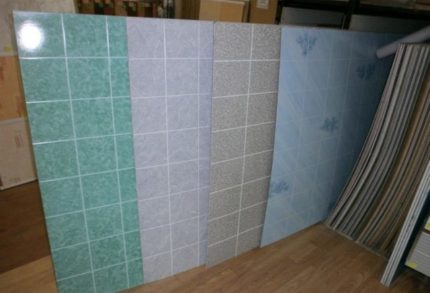
Sectional plastic panels are used much more often due to lower cost and ease of assembly - the cladding is mounted on a pre-created frame.
There are two types of products.
- Lining - the most inexpensive type of plastic panels, which are fixed to each other by a European lock connection. The presence of a groove and a ridge contributes to the maximum density of the seam, however, the junction of the lamellas remains very noticeable. Therefore, in the interior lining is used less often, as it looks less aesthetically pleasing.
- Wall panels PVC are a better option for interior decoration and are often used for repairs in the bathroom. With strict observance of the installation technology, the junction remains almost invisible.
The shade, all kinds of patterns and surface texture depend on the type of panels. So, laminated panels get color and texture due to gluing with thick PVC film. AND offset they are painted using a printer, after which the drawing is covered with a layer of special varnish. Like laminated lamellas, offset can also repeat the texture of wood or stone.
Thermal transfer PVC panels are processed using a film. Thermal transfer material is pressed to the surface of the lamella using a heated drum, after which the pattern is transferred to the product. Film and varnish act as image protection.
Due to the variety of colors and patterns, plastic panels practically do not limit the owners in creating a modern and attractive bathroom design.
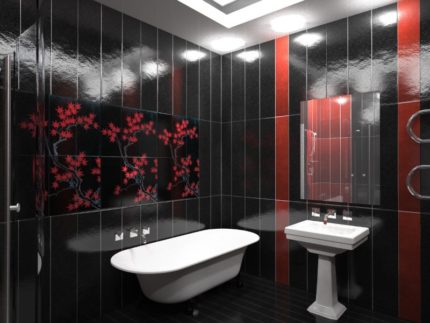
In addition to the walls, plastic ceiling can also be decorated. Such a solution will help to hide the wires of the lighting fixtures.
Advantages and disadvantages of paneling
Wall cladding with PVC panels has several advantages.
In addition to an attractive price, it is worth noting such advantages of this material:
- ease;
- simplicity of trimming that can be done with an office knife or grinderequipped with a thin disc for metal;
- unpretentiousness in leaving;
- durability;
- resistance to external aggressive environment;
- undemanding care;
- operational installation;
- the ability to hide communications under the main frame.
When calculating the required amount of material, remember to trim the panels. If you plan to use products with a complex pattern, increase the calculated number of sections in advance by about 10-15%.
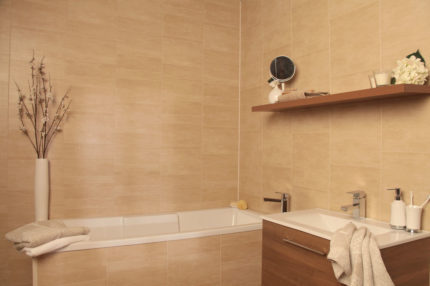
However, like any other finishing material, plastic panels have some negative features:
- products are extremely sensitive to point impacts, so through holes are easily formed on their surface;
- when exposed to sunlight, the picture on the panel may fade;
- PVC is a completely flammable material: plastic can withstand quite high temperatures, but during the melting process it releases extremely toxic substances;
- for true connoisseurs of quality materials, the texture and appearance of plastic panels may not be attractive enough.
The disadvantages of plastic lamellas, provided that the bathroom is finished, are insignificant. Therefore, budget material is so often used to speed up and reduce the cost of repairs in this room.
Methods of mounting plastic panels
There are two methods for installing plastic panels on the walls and ceiling in the bathroom: frame and frameless. Each of them has its own characteristics and is optimal for certain types of panels.
Option # 1 - frameless panel fixing
To make mounting without a frame using glue is most appropriate if sheet panels are selected for decoration.
An important condition for the quality of work is the preliminary preparation of the wall: leveling the surface in level, eliminating bulges and depressions.
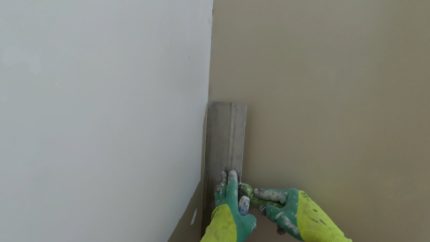
The advantage of this method is the almost seamless wall cladding provided that large sheets are purchased. In addition to a more thorough preparation of the wall than using the frame method, the disadvantages include the lack of the ability to filigree hide the wiring or even pipes under the lining.
When choosing glue, it is very important to take into account its features and aggressiveness with respect to plastic. Choose only products suitable for PVC, as glue for other finishing materials can cause deformation of the panel.
Option # 2 - mounting panels on a frame
The frame in the form of a lathing is a great way to hide possible irregularities in the wall and securely fasten sectional plastic panels. An additional bonus will be the ability to replace the wiring in the bathroom without breaking the walls: thanks to the space under the future cladding, the cable can be run directly over the wall. In the same niches under the false panel, it is permissible to leave the wiring of water pipes.
The preparation of walls under the frame is more aimed at processing with antiseptic drugs that prevent the formation of fungus.
Direct wall leveling can be treated more superficially, filling only obvious cavities with putty and slightly sharpening the protrusions. It is necessary to set the ideal plane of the future cladding surface at the stage of installation of the crate: each of its elements is fixed to the wall with dowels or self-tapping screws after preliminary fitting of parts with the help of a level.
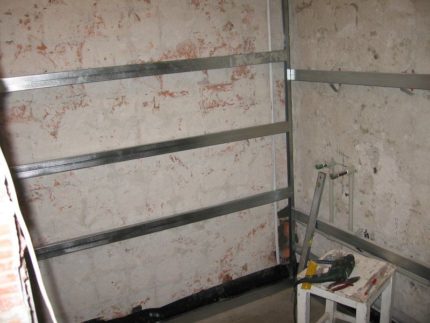
For the manufacture of the frame, you can use wooden battens or a metal profile, which is intended for the installation of drywall:
- Wooden crate remains a cheaper option. However, high humidity in the bathroom can adversely affect the natural material, so the tree must be treated with an antiseptic and protective fluids.
- Metal frame will cost a little more, but such a design is less prone to deformation. To avoid corrosion processes for installation as long as possible, it is better to use galvanized metals.
The position of the elements in the frame can be vertical or horizontal and depends on the direction of the calculation of the panels themselves. Most often, the crate is mounted horizontally, since PVC lamellas are fixed vertically on it. The step between the battens of the crate or frame should not exceed 30-40 cm.
You can fasten the panels to the frame with a construction stapler, small self-tapping screws, if the design is made of wooden battens. For fastening lamellas on a metal profile, self-tapping screws are used.
Additional elements for sectional mounting
In addition to the sectional panels themselves, for the implementation of high-quality installation, additional plastic elements will be needed.
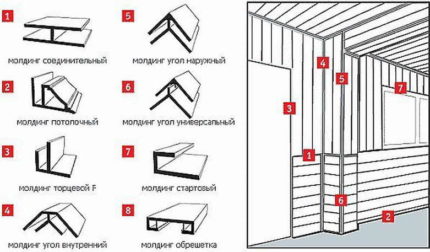
A variety of angles, profiles and moldings allow you to securely and aesthetically attach panels to the frame:
- Universal corner Will be required to finish the internal and external corners in the bathroom.
- Outside corner used to hide the connection of panels on the outer corner.
- Ceiling and skirting boards have a more complex configuration. The inner part of the product is fixed under the panels, and the outer one covers their slice.
- Connecting profile makes it possible to fasten lamellas together when their length is insufficient to completely cover the wall surface.
- Starting and finish profiles used to decorate the first and last sheet of the panel and can be replaced by universal corners.
The use of other profiles depends on the number of angles and kinks on the wall surface.
The subtleties of assembling panels on the frame
Assembling the entire structure is quite simple and quick and in many ways resembles folding a puzzle:
- The first panel is inserted into the start profile and fixed on the frame.
- The second panel is connected to the first using the built-in lock mechanism.
- After securing the second panel, the third lamella is mounted on the crate.
- The process continues to the corner of the wall, which is pre-equipped with an angular profile.
After finishing the cladding of the first wall, it is necessary to proceed to the finish of the next, bringing the new panel into the corner profile.

In fact, for an independent and high-quality assembly of sectional elements, the owner needs to fulfill several important conditions. First, slightly level the surface of the walls and treat them with a deep penetration primer, antiseptic and antifungal agents.
Then build the crate or frame strictly according to the level and fix the additional elements of the profiles for high-quality installation.
Compliance with this technology will make it possible to obtain a smooth coating without obvious joints.
Conclusions and useful video on the topic
The repair and decoration master shows in this video a finished project of a bathroom lined with plastic panels. A spectacular interior was created in one day:
A step-by-step instruction for wall decoration with plastic panels is presented by the master in the next video. A professional demonstrates all stages of repair work from creating a frame to installing sections:
Cladding the walls and ceiling of the bathroom with plastic panels is a quick and inexpensive way to make a spectacular and durable finish. The cheapness of the material, the variety of colors and installation, which does not require special skills, make it possible to quickly complete the repair and refresh the room without any special costs.
If desired, homeowners can periodically radically change the interior, because the dismantling of panels is simple, and the previously assembled frame is suitable for fixing new slats.
Still have questions about installing plastic panels? Or want to tell how you personally assembled PVC lamellas on a frame and what difficulties did you encounter? Share your personal experience, ask questions to our experts, add original photos of your bathroom with plastic panel trim in the comment block. It is located below, under this publication.

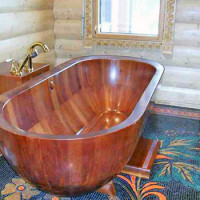 Bathroom in a wooden house: the rules of arrangement and features of decoration
Bathroom in a wooden house: the rules of arrangement and features of decoration 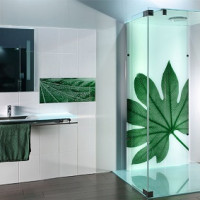 Types of showers: varieties, the best manufacturers + selection tips
Types of showers: varieties, the best manufacturers + selection tips 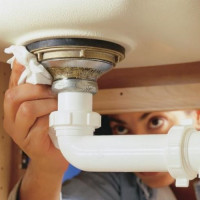 How to install a bath yourself: a step-by-step installation guide
How to install a bath yourself: a step-by-step installation guide 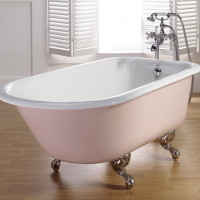 DIY cast iron bathtub installation: a detailed step-by-step guide
DIY cast iron bathtub installation: a detailed step-by-step guide 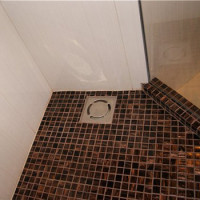 How to make a floor drain for a shower under a tile: a guide to construction and installation
How to make a floor drain for a shower under a tile: a guide to construction and installation 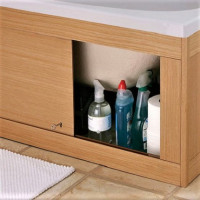 Sliding screen for the bath: step-by-step instructions for assembling the factory design + tips for craftsmen
Sliding screen for the bath: step-by-step instructions for assembling the factory design + tips for craftsmen  How much does it cost to connect gas to a private house: the price of organizing gas supply
How much does it cost to connect gas to a private house: the price of organizing gas supply  The best washing machines with dryer: model rating and customer tips
The best washing machines with dryer: model rating and customer tips  What is the color temperature of light and the nuances of choosing the temperature of the lamps to suit your needs
What is the color temperature of light and the nuances of choosing the temperature of the lamps to suit your needs  Replacement of a geyser in an apartment: replacement paperwork + basic norms and requirements
Replacement of a geyser in an apartment: replacement paperwork + basic norms and requirements